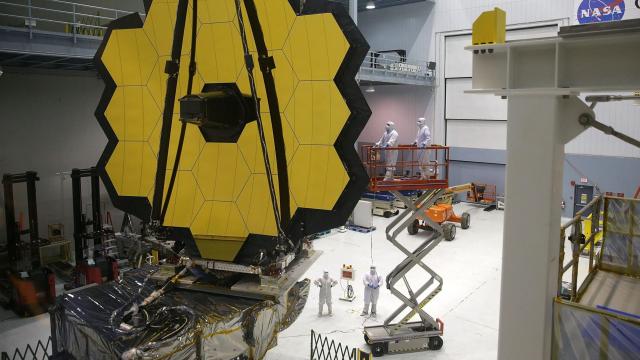Astronomers, scientists, and space-hobbyists all over the world are nervously chewing their nails this holiday season over the Christmas Day launch of the James Webb Space Telescope. If all goes according to plan, liftoff will take place on Dec. 25 at 11:20 p.m. AEDT. If you’re in French Guiana, you can watch the launch live at the Guiana Space Centre in Kourou. If you’re not, you can check out NASA’s livestream.
What is the James Webb Space Telescope?
The James Webb telescope is the biggest, most complex telescope that NASA has ever launched into space, a mission on-par in importance and complexity with the Apollo missions and the launch of the space shuttle. In development since 1996, the telescope is the next-generation successor to the Hubble space telescope. Its huge golden mirror will allow us to see further into space and further back in time than we ever have before.
“Twenty-nine days on the edge”
In a video, NASA dubbed the launch and deployment phase of the Webb mission 29 Days on the Edge. It’s easy to see why: The plan for deployment of the telescope is audacious and fraught with possible disaster. Right now, the telescope’s 6.40 m diameter mirror, made of gold-plated beryllium, and its five-layer heat-shield the size of three tennis courts are folded and crammed into a tiny, 5.4-metre diameter rocket faring sitting on a launch pad in South America. Weather permitting, it will be shot into space on Christmas, and once outside the Earth’s atmosphere, the mirror, heat shield, and instruments will unfold and assemble themselves into a telescope during a 30-day journey to a spot a million miles away from our planet.
The first hurdle is the actual trip off Earth — a rocket malfunction is unlikely, but could obliterate the ten billion dollar project in an instant — but the real drama will come after the telescope is deposited in space, when hundreds of systems must perform perfectly for the telescope to self-assemble and cruise to its destination.
“We’ll have our 29 days of terror as we’re watching things being deployed,” astronomer Garth Illingworth of the University of California, Santa Cruz told NPR.
“I have images in my head of a half-unfolded mirror stuck in place, which would be very bad, something like what happened to the Galileo spacecraft with its main antenna getting stuck during the fold-out process,” Scott Sheppard of the Carnegie Institution for Science said.
If something does go wrong, there won’t be much we can do to correct. The Hubble telescope, deployed in 1990, had problems with its mirror, but it was in a low-Earth orbit, so astronauts were able to service the satellite and patch the mirror problem. When a telescope is a million miles away from us, no one is going to be able to correct anything, at least not directly.
Looking beyond time itself
If everything goes according to plan, the telescope will be operational in about six months, and that’s when things get interesting. The Webb’s beryllium mirror is designed to capture infrared light emitted by distant planets and galaxies, allowing us to see as far back in time as it’s possible to see luminous objects. We’ll be able to look at the formation of the first galaxies created by the Big Bang, and learn about the role dark matter may have played in the formation of the Universe.
The Webb telescope will also scan the atmospheres of distant planets for the building blocks of life, hopefully identifying habitable worlds and/or telling us where all the flying saucers are coming from.
Maybe the most exciting discoveries from the Webb will be the ones we can’t possibly predict. The deeper view of space provided by the telescope’s equipment could reveal some aspect of space or time we’d have had no way of knowing about before, potentially creating entirely new fields of scientific study. Depending, of course, on the thing getting into space without blowing up.

Leave a Reply
You must be logged in to post a comment.